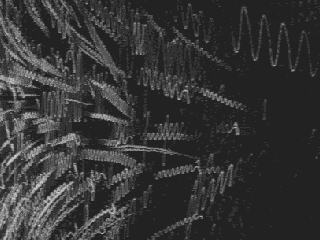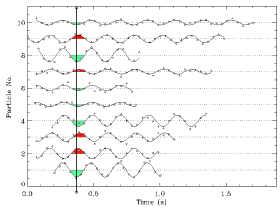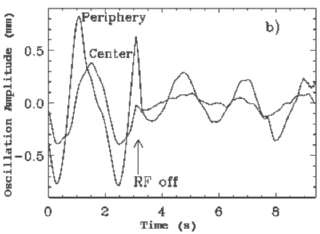|
|
Coagulation Experiment
 The following movies show a charge enhanced coagulation process
as it has been observed during an experiment of PKE Nefedov on
board the International Space Station.
The following movies show a charge enhanced coagulation process
as it has been observed during an experiment of PKE Nefedov on
board the International Space Station.Download MPEG movie: low quality (3.5 MB), high quality (11.5 MB). During this experiment the plasma is turned off. Within a fraction of a second after the injection some 100,000 particles get together to form a big agglomerate (big blob in the center, magnified in the right image) together with many smaller clusters (with totally the same mass as the big one). This result indicates a "run-away process". Further investigations showed that the clusters were charged, positively or negatively. The standard (Smoluchovski's) coagulation equation cannot explain the observed features of the aggregation kinetics. We therefore generalized the coagulation equation taking into account the enhancement of the coagulation rate due to charge-induced attraction. Analysis shows that the equation indeed allows the "run-away", or "gelation" solution, whereby one very massive particle is formed at a certain (gelation) moment tgel. Two phases - gel ("infinite" aggregate) and sol (clusters of finite size) - coexist at t>tgel. Thus, the proposed theory describes the observed features of the aggregation process. The derived value of tgel agrees well with the measured time-scale of the large agglomerate formation. 
 Superposition of several video frames. You can clearly see the oscillations of single particles, which means that they carry an electric charge (left). A comparision of the oscillation phases shows that there exists nearly the same number of positive and negative charges (right).
Due to this experiment we might soon understand what happens in the
early phase of planetary formation in a protoplanetary disk and how
from microscopic particles finally planets like the Earth form -
with the help of electrical charging.
Further experiments on coagulation are planned. De-charging of particlesIn the "decharging experiment" the rest charge on the microparticles was measured after the plasma was switched off. To measure this, the particles were exposed to a sinusoidally varying electric field (at low frequencies around 0.5 Hz) and - if they remain charged - one can simply determine the charge from the oscillation amplitude shown in the figures below.
 Figure a) shows the particle motion upwards separately for particles in the periphery and the centre. The time when the plasma is switched off is shown in the graph. Subtracting the thermophoretic from the oscillatory motion we receive the oscillation amplitude in b).
On Earth such a measurement is practically impossible - the particles
fall down too quickly and charge measurements are consequently very
difficult to perform. This decharging experiment showed that the
particles are not totally discharged after the plasma is turned off.
They retain a "frozen" charge after the plasma electrons and ions have
disappeared. This is a new insight from complex plasma physics and
might be important for many other processes, including industrial
applications.
Publication: A. Ivlev, M. Kretschmer, M. Zuzic, et al., Phys. Rev. Letters Vol.90 No.5, Feb. 2003 More results (3)... |
|
|